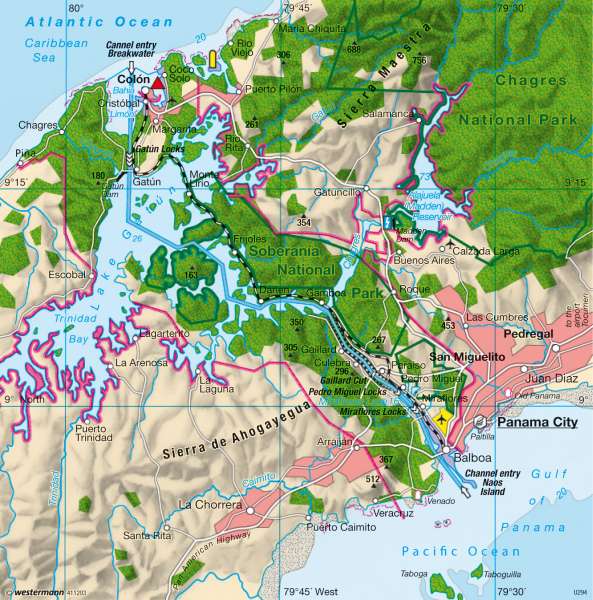Panama Canal — Connecting two oceans
The Americas - Economy
978-3-14-100790-9 | Page 131 | Ill. 2

Information
Panama covers an area of 75,517 km² over the narrowest part of the Central American land bridge. The territory of Panama is divided into a western and an eastern half on the Isthmus by the Canal. Since 1914, the artificial waterway has provided a connection between the Atlantic and the Pacific Ocean. As an alternate route around Cape Horn, (the southern tip of South America) it shortens the sea route from New York to Los Angeles to nearly 8,000 nautical miles or 15,000 km. An average of 14,000 ships pass through the canal every year. The passage takes about twelve hours.The Canal
The channel of the Panama Canal is 81.6 kilometres long, has a depth of 14.3 metres and a minimum width of 152.4 metres. Three lock systems — the Miraflores, Pedro Miguel and Gatun — allow ships to negotiate a 26 metre height difference, while crossing the continent between Colón and Panama City.
The size of the 305 metre long and 33.5 metre wide locks has long been a benchmark for the construction of ships on the high seas. Currently, two of the so-called Panamax-class ships (width: 32 metres, length: 294 metres, draught: 12 metres) can pass through the same channel in the oncoming traffic. In order to operate the lock facilities, the Miraflores Lake and the 426 km² Gatun Lake were dammed. The canal is only loaded with fresh water that is flushed when emptying the locks into the sea. Therefore in drought years, the numbers of passing vessels are greatly reduced. Around 8,000 people provide 24 hours services for the smooth operation of the Panama Canal.
The canal, and its related services, economically forms the backbone of the Panamanian economy. The fees for the canal passage cover a large part of the state budget.
History of the canal construction
The idea of a canal puncture had already emerged in the 16th Century. Even before the construction of the canal, the Isthmus of Panama was a much used transit route from around 1855. Firstly, persons and goods carried by mules were taken overland by the railroad. A few years later, Ferdinand de Lesseps formed a canal company and began with construction in 1879. However, ten years later he was forced to declare bankruptcy. Also, the successor company failed in 1899 due to financial difficulties.
In response, the United States acquired the sole right to completion of the canal from the French in 1901. When negotiations with the Colombian government over the transfer of the Canal Zone failed, (in 1903), the U.S. supported the Panamanian secession from the state union with Colombia. In return for this, the newly formed Republic of Panama allowed the United States unlimited rights to use the canal construction area and legal intervention.
On 15 August 1914, the Panama Canal opened. In the hitherto largest and most expensive construction in the world, until its completion, some 25,000 workers (mostly of Caribbean origin) lost their lives through tropical diseases and accidents.
On 1 January, 2000, the sovereign rights to the Canal Zone were completely handed over to Panama by the United States.
Meanwhile, the Panama Canal — after the Suez Canal, the most important waterway in the world — met its capacity limits. As the Panama Canal is the most important source of income by far for the state, it was decided in 2006 to expand the waterway.
U. Kleinelümern; Ü: Colette Fleming




